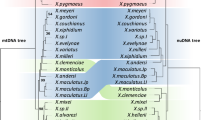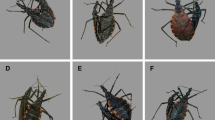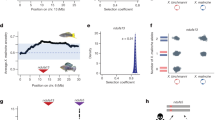Abstract
‘Second-order’ models for meiotic analysis have been developed for tetraploid and pentaploid hybrids to address a number of situations intermediate between the established ‘first-order’ models. They all incorporate a third parameter of relative affinity, z, intermediate between x and y, the relative affinities of the most and least closely related genomes respectively. Four such models are described: a 2:(1:1) and a (2:1):1 for tetraploid hybrids; and a 2:(1:1):1 and a (2:1):1:1 for pentaploid hybrids. Examples of their application are given. Where z≈x, or z≈y, then interpretation through the simpler first-order models is appropriate. In other cases application of second-order models can reveal more subtle relationships among the genomes in a hybrid.
Similar content being viewed by others
Article PDF
References
Alonso, L C, and Kimber, G. 1983. A study of genome relationships in wheat based on telocentric chromosome pairing. II. Z Pflanzenzüchtg, 90, 273–284.
Bell, G D H, and Sachs, L. 1953. Investigations in the Triticinae II. The cytology and fertility of intergeneric and interspecific F1 hybrids and their derived amphidiploids. J Agric Sci, 43, 105–115.
Bothmer, R, Von Flink, J, and Landström, T. 1988. Meiosis in interspecific Hordeum hybrids. IV. Tetraploid (4x × 4x) hybrids. Genome, 30, 479–485.
Chapman, C G D, and Kimber, G. 1992a. Developments in the meiotic analysis of hybrids. I. Review of theory and optimization in triploids. Heredity, 68, 97–103.
Chapman, C G D, and Kimber, G. 1992b. Developments in the meiotic analysis of hybrids. II. Amended models for tetraploids. Heredity, 68, 105–113.
Chapman, C G D, and Kimber, G. 1992c. Developments in the meiotic analysis of hybrids. III. Amended models for pentaploids. Heredity, 68, 193–200.
Chapman, C G D, and Kimber, G. 1992d. Developments in the meiotic analysis of hybrids. IV. Utilizing datasets with merged classes. Heredity, 68, 201–204.
Crane, C F, and Sleper, D A. 1989a. A model of meiotic chromosome association in triploids. Genome, 32, 82–98.
Crane, C F, and Sleper, D A. 1989b. A model of meiotic chromosome association in tetraploids. Genome, 32, 691–707.
Cuñado, N, Cermeño, M C, and Orellana, J. 1986. Interactions between wheat, rye and Aegilops ventricosa chromosomes on homologous and homoeologous pairing. Heredity, 56, 219–226.
Cuñado, N, Cermeño, M C, and Orellana, J. 1988. Interactions between wheat, rye and Aegilops ventricosa chromosomes on homologous and homoeologous pairing. Heredity, 56, 219–226.
Dajun, L, and Kimber, G. 1982. The utilization of 4x amphidiploids in the genomic analysis of wheat. Z Pflanzenzüchtg, 88, 302–310.
Dhaliwal, H S. 1977. The Ph gene and the origin of tetraploid wheats. Genetica, 47, 177–182.
Espinasse, A, and Kimber, G. 1981. The analysis of meiosis in hybrids. IV Pentaploid hybrids. Can J Genet Cytol 23, 235–254.
Kihara, H, and Tanaka, M. 1970. Addendum to the classification of the genus Aegilops by means of genome analysis. Wheat Information Service, 30, 1–2.
Kimber, G, and Alonso, L C. 1981. The analysis of meiosis in hybrids. III. Tetraploid hybrids. Can J Genet Cytol, 23, 235–254.
Kimber, G, and Yen, Y. 1989. Hybrids involving wheat relatives and autotetraploid Triticum umbellulatum. Genome, 32, 1–5.
Kushnir, U, and Halloran, G M. 1983. Evidence on the origin of the G genome in wheat: cytology and fertility of a Triticum timopheevi-like mutant. Can J Genet Cytol, 25, 651–661.
Leont'Ev, F P, and Budashkina, E B. 1981. Cytological study of interspecific pentaploid Triticum aestivum × T. timopheevii F1 hybrids. Cytol Genet 14, 54.
Mello-Sampayo, M. 1971. Genetic regulation of meiotic chromosome pairing by chromosome 3D of Triticum aestivum. Nat New Biol, 230, 22–23.
Shands, H, and Kimber, G. 1973. Reallocation of the genomes of Triticum timopheevii Zhuk. Proc Fourth Int Wheat Gen Symp, 101–108.
Watanabe, Y. 1953. Studies on meiosis, morphology and fertility in F1 hybrids: Triticum timopheevii Zhuk. × Triticum vulgare. Jap J Breeding, 2, 173–177.
Watanabe, Y, and Mukade, K. 1955. Maturation division if F1 hybrids between five species in the dinkel group and Triticum timopheevii Zhuk. Jap J Genet, 30, 24–33.
Yen, Y, and Kimber, G. 1989. A triploid hybrid between autotetraploid Triticum longissimum and T. speltoides. Cereal Res Commum, 17, 259–264.
Zohary, D, and Feldman, M. 1962. Hybridization between amphidiploids and the evolution of polyploids in the wheat (Aegilops-Triticum) group. Evolution, 16, 44–61.
Author information
Authors and Affiliations
Rights and permissions
About this article
Cite this article
Chapman, C., Kimber, G. Developments in the meiotic analysis of hybrids. V. Second-order models for tetraploids and pentaploids. Heredity 68, 205–210 (1992). https://doi.org/10.1038/hdy.1992.33
Received:
Issue date:
DOI: https://doi.org/10.1038/hdy.1992.33
Keywords
This article is cited by
-
A critical review of concepts and methods used in classical genome analysis
The Botanical Review (1998)
-
Developments in the meiotic analysis of hybrids. II. Amended models for tetraploids
Heredity (1992)



